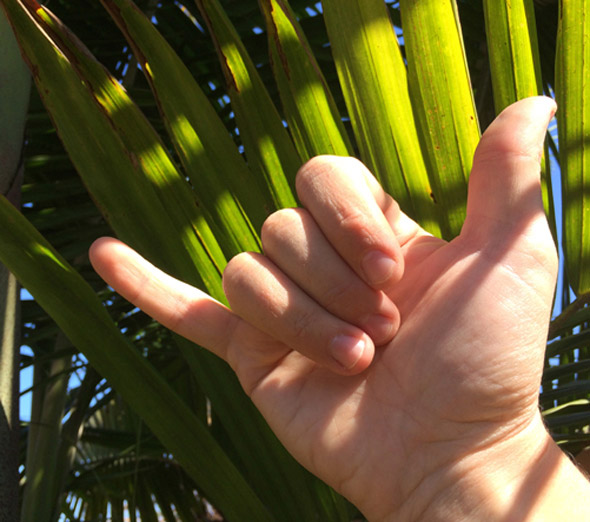SHAKING IT UP WITH HAWAII’S SHAKA SIGN

It shouldn’t be a shaka that Hawaii’s most well-known hand gesture is also known or referred to as the “hang loose” sign. Though there is no literal translation or meaning for the shaka, it is most commonly used to convey the aloha spirit as a motion of greeting or thanks. In Hawaii you’ll frequently see drivers flashing a shaka sign on the road to say hello or to say thanks.
It’s believed that the shaka originated amongst surfers, and today is actually one of two signs which refers to surfing according to American Sign Language.
Unlike many signs used today, the shaka sign has no official definition. Across the world, other countries use and interpret similar signs to the shaka though it carries different meanings. For example, in Brazil the shaka sign is associated with Brazilian jiu jitsu, while in China in symbolizes the number six.
Shaka’s Start
There are more stories in Hawaii on how the shaka came to be then there are fingers on one hand. One legend told by Hawaii locals, credits the shaka to a local Laie resident who lost three middle fingers on his hand while working at a sugar mill. Because of the accident, he was moved to guard the sugar train, and used the sign to signal “all clear” and to shoo young keiki (children) from jumping the trains. Over time, the gesture evolved as children and other island residents mimicked it.
Another credits the shaka to the Polynesian Cultural Center’s well-known face, Kalili, who waves at guests and his even more well-known hand, which many say closely resembles the shape of the frequently replicated shaka drawing. Others say the shaka came from a surfer who had his middle fingers bitten off by a shark, and still more say the sign originated with immigrants who folded their middle fingers down to indicate sharing a drink with the Hawaiians they encountered on the island.
Regardless of how the shaka came to be, almost all Hawaii residents agree that the name “shaka” came from a popular TV car ad in the 1960′s by local TV and movie host, Lippy Espinda, who made frequent use of the hand gesture. The commercials became a hit with locals as did the commercial’s catch phrase, “shaka braddah!”
Years later, in 1976, the shaka sign became a popular sight in political campaigns as mayoral candidate Frank Fasi used it to encourage voters.
No matter who or where it came from, today the shaka sign lights up billboards, ads and sidewalks across Hawaii nei and has the power to instantly unite two people anywhere in the world — from a sign of aloha amongst two snowboarders on the slopes in Canada to travelers stuck in an European airport, simply saying hello. The shaka is a sign that says “aloha, we are the same.”
How to Shaka
Shaking a shaka is simple!
- Make a light fist.
- Extend your thumb and pinky finger (make sure to leave your three middle fingers curled down!).
- With your knuckles facing out, most kamaaina (locals) “wave” the shaka by moving their hand back and forth from side to side.
So when you’re in Hawaii, shake it like you’ve got it! Flash a shaka to the driver who let you through, the valet when they bring around your car — or better yet share it as a sign of aloha with your friends and family back home.
